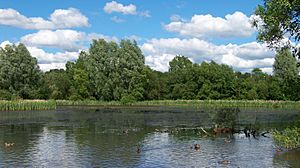Whitfield Valley facts for kids
Quick facts for kids Whitfield Valley |
|
|---|---|

The lake near Ford Green
|
|
| Lua error in Module:Location_map at line 420: attempt to index field 'wikibase' (a nil value). | |
| Location | Stoke-on-Trent |
| Area | 91.15 hectares (225.2 acres) |
| Operated by | Stoke-on-Trent City Council |
| Designation | Local nature reserve |
| Website | Whitfield Valley |
Whitfield Valley is a special place in Stoke-on-Trent, England. It is a local nature reserve, which means it's protected to help nature and wildlife thrive. You can find it on the northern edge of the city.
Contents
Welcome to Whitfield Valley!
Whitfield Valley is a large nature reserve that covers about 91 hectares. To give you an idea, that's like 127 football fields! This amazing area was officially made a local nature reserve (LNR) in 1991. It is looked after by the Stoke-on-Trent City Council, who work hard to keep it a great home for plants and animals.
What is a Nature Reserve?
A local nature reserve, or LNR, is a place where nature is protected and managed for both wildlife and people. These areas are important because they help to keep different types of plants and animals safe. They also give people a chance to enjoy nature and learn about the environment. Whitfield Valley is a perfect example of how a city can have a wild, natural space right on its doorstep.
Exploring the Landscape
Whitfield Valley is a mix of different natural areas. You'll find open grassland, areas of heathland with small shrubs, peaceful lakes, and scattered trees. This variety of habitats makes it a home for many different creatures.
Waterways and Special Areas
The Ford Green Brook flows right through the middle of the reserve, heading south. It runs between the areas of Chell and Bradeley on one side, and Norton le Moors on the other. At the northern end of the reserve, you can see what used to be a large pile of waste from the old Chatterley Whitfield coal mine. Down in the south, near Ford Green, there's a special area called a reed bed. This reed bed is so important for wildlife that it's been named a Site of Special Scientific Interest (SSSI). This means it's one of the best places in the country for certain plants and animals.
Amazing Wildlife
Whitfield Valley is full of life! Because it has so many different types of habitats, you can spot a wide range of plants and animals here. It's a great place for nature lovers and anyone interested in seeing wildlife up close.
Plants and Butterflies
On the old coal mine spoil heap, you might find a plant called Birdsfoot trefoil. This plant is super important because it's the main food source for the caterpillars of the dingy skipper butterfly. These butterflies are quite rare, so seeing them here is a real treat!
Birds of the Valley
The open grasslands of Whitfield Valley are perfect for birds like skylarks. You might hear their beautiful songs as they fly high above. You could also spot grey partridges, which are ground-nesting birds that blend in well with their surroundings. The lakes in the reserve are a busy home for many different water birds, so keep an eye out for ducks, geese, and other feathered friends enjoying the water.

